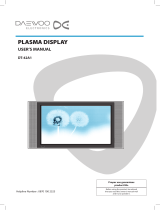
2.1 Precautions
• Do not lift or swing the product only by the power cord or signal cable.
Otherwise, the power cord may be damaged and cause product failure,
a fire or an electric shock.
• Before you move the product, be sure to turn off the power switch and
remove all the connected cables, including the power cord. Otherwise,
the power cord may be damaged and cause an electric shock or fire.
• Do not let your child hang on to or mount the product. Otherwise, the
product may fall, and your child may be injured or even killed.
• Neither let the product fall nor apply force to it. Otherwise, an electric
shock or fire may result.
• If there is a gas leak, do not touch the product or power plug; instead,
ventilate the room immediately. Otherwise, a spark can cause an ex-
plosion or fire. During a thunderstorm or lightning, do not touch the
power cord. Otherwise, product failure or personal injury may result.
• Neither use nor keep combustible spray or an inflammable substance
near the product. Otherwise, an explosion or fire may result.
• Be sure the vent is not blocked by a table cloth or curtain. Otherwise, a
fire may result from an increase in internal temperature.
• Do not put a metallic object or an object that contains liquid (a flower
vase, a flowerpot, a drink, toiletries, medicines, etc.) on top of the prod-
uct. If water or any foreign substance enters the product, remove the
power cord, and contact Samsung’s service center. Otherwise, product
failure, a fire, or an electric shock may result.
• Do not insert a metallic object (a chopstick, coin, hair pin, etc.) or in-
flammable object (paper, match, etc.) into the vent or ports of the prod-
uct. If water or any foreign substance enters the product, be sure to
power off the product, remove the power cord, and contact Samsung’s
service center. Otherwise, product failure, a fire, or an electric shock
may result.
• Displaying the same picture for many hours may cause an afterimage
or stain. If you will not use the product for many hours, activate power-
saving mode or the moving-picture screen saver.
• Configure the appropriate resolution and frequency for the product.
Otherwise, your eyesight may weaken.
• Continuously watching the display from a close distance may weaken
your eyesight.
• Rest your eyes for at least five minutes every hour. This will relieve
your eye fatigue.
• Keep small-sized accessories in a place that cannot be reached by chil-
dren.
• If you will not use the product for a long time, remove the power cord
from the power socket. Otherwise, a fire may result from accumulated
dust, overheating, an electric shock, or electric leakage.
• Do not move or hold the product upside down only by the stand. Oth-
erwise, the product may fall and break or cause personal injury.
• Do not put the product near a humidifier or the kitchen table. Other-
wise, an electric shock or fire may result.
• The display panel becomes hot when the product is on for many hours.
• Be careful when you adjust the product angle or stand height. Other-
wise, you may pinch your hand or finger. Tilting the product exces-
sively may cause it to fall and result in personal injury.
• Do not put a heavy object on top of the product. Otherwise, product
failure or personal injury may result.
• Be sure your child does not put a battery from the remote control in his
mouth. If your child swallows a battery, consult a doctor immediately.
• Be sure you use specified batteries. Do not use a new and used battery
together. Otherwise, a fire, personal injury, or contamination may result
from an explosion or internal fluid leakage of the batteries.
◀ 6 ▶




















